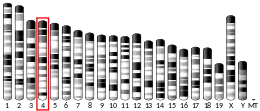Calbindin 1
Calbindin 1 is a protein that in humans is encoded by the CALB1 gene. It belongs to the calbindin family of calcium-binding proteins, along with calretinin (CALB2). [5]
Function
The protein encoded by this gene is a member of the calcium-binding protein superfamily that includes calmodulin and troponin C. Originally described as a 27 kDa protein, it is now known to be a 28 kDa protein. It contains four active calcium-binding domains, and has two modified domains that are thought to have lost their calcium binding capability.[6] This protein is thought to buffer entry of calcium upon stimulation of glutamate receptors. Depletion of this protein was noted in patients with Huntington disease. [provided by RefSeq, Jan 2015].
References
- GRCh38: Ensembl release 89: ENSG00000104327 - Ensembl, May 2017
- GRCm38: Ensembl release 89: ENSMUSG00000028222 - Ensembl, May 2017
- "Human PubMed Reference:". National Center for Biotechnology Information, U.S. National Library of Medicine.
- "Mouse PubMed Reference:". National Center for Biotechnology Information, U.S. National Library of Medicine.
- "Entrez Gene: Calbindin 1". Retrieved 2018-10-04.
- Noble JW, Almalki R, Roe SM, Wagner A, Duman R, Atack JR (October 2018). "The X-ray structure of human calbindin-D28K: an improved model". Acta Crystallographica Section D. 74 (Pt 10): 1008–1014. doi:10.1107/s2059798318011610. PMC 6173056. PMID 30289411.
Further reading
- Tao L, Murphy ME, English AM (May 2002). "S-nitrosation of Ca(2+)-loaded and Ca(2+)-free recombinant calbindin D(28K) from human brain". Biochemistry. 41 (19): 6185–92. doi:10.1021/bi015846+. PMID 11994015.
- Berggard T, Szczepankiewicz O, Thulin E, Linse S (November 2002). "Myo-inositol monophosphatase is an activated target of calbindin D28k". J. Biol. Chem. 277 (44): 41954–9. doi:10.1074/jbc.M203492200. PMID 12176979.
- Belkacemi L, Gariépy G, Mounier C, Simoneau L, Lafond J (June 2003). "Expression of calbindin-D28k (CaBP28k) in trophoblasts from human term placenta". Biol. Reprod. 68 (6): 1943–50. doi:10.1095/biolreprod.102.009373. PMID 12606474.
- Cedervall T, Berggård T, Borek V, Thulin E, Linse S, Akerfeldt KS (January 2005). "Redox sensitive cysteine residues in calbindin D28k are structurally and functionally important". Biochemistry. 44 (2): 684–93. doi:10.1021/bi049232r. PMID 15641794.
- Vanbelle C, Halgand F, Cedervall T, Thulin E, Akerfeldt KS, Laprévote O, Linse S (April 2005). "Deamidation and disulfide bridge formation in human calbindin D28k with effects on calcium binding". Protein Sci. 14 (4): 968–79. doi:10.1110/ps.041157705. PMC 2253450. PMID 15741335.
- Valencia I, Legido A, Yelin K, Khurana D, Kothare SV, Katsetos CD (December 2006). "Anomalous inhibitory circuits in cortical tubers of human tuberous sclerosis complex associated with refractory epilepsy: aberrant expression of parvalbumin and calbindin-D28k in dysplastic cortex". J. Child Neurol. 21 (12): 1058–63. doi:10.1177/7010.2006.00242. PMID 17156698. S2CID 36971471.
- Vig PJ, Wei J, Shao Q, Hebert MD, Subramony SH, Sutton LT (June 2007). "Role of tissue transglutaminase type 2 in calbindin-D28k interaction with ataxin-1". Neurosci. Lett. 420 (1): 53–7. doi:10.1016/j.neulet.2007.04.005. PMC 1949022. PMID 17442486.
- Zhang C, Sun Y, Wang W, Zhang Y, Ma M, Lou Z (February 2008). "Crystallization and preliminary crystallographic analysis of human Ca 2+-loaded calbindin-D28k". Acta Crystallographica Section F. 64 (Pt 2): 133–6. doi:10.1107/S1744309108001905. PMC 2374171. PMID 18259068.
- Bauer MC, Nilsson H, Thulin E, Frohm B, Malm J, Linse S (April 2008). "Zn2+ binding to human calbindin D(28k) and the role of histidine residues". Protein Sci. 17 (4): 760–7. doi:10.1110/ps.073381108. PMC 2271158. PMID 18359862.
This article incorporates text from the United States National Library of Medicine, which is in the public domain.




